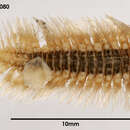tr
kırıntılardaki isimler


“Antinoë setobarba, n.sp.
St. 195. 30. iii. 27. Admiralty Bay, King George Island, South Shetlands. 62° 07' 00" S, 58° 28' 30" W. 391 m. Gear OTM. Bottom: mud and stones. One specimen.
The dorsal (Fig. 19, c) bristles are numerous and exceedingly fine capillaries, which appear to be quite smooth, but under a very high magnification minute serrations (Fig. 19, d) can be detected on one side of the blade.
The ventral bristle bundle is contained between two vertical lips, the anterior of which is produced into an extremely long cirriform process, almost reaching to the tips of the bristles. The ventral bristles (Fig. 19, e), although coarser than the dorsal, are very long and slender, and end in fine hair-like tips. They carry rows of delicate closely set teeth. The ventral cirri are short, just reaching to the lip of the chaeta sac. The example (Fig. 19, f) is a ripe female, filled with ova.
REMARKS. I find this specimen very puzzling. It was apparently obtained from the bottom of the sea, and the head and the sturdy character of the body are not those of a pelagic form : on the other hand, the large inflated-looking cirrophores and the long very delicate bristles recall the free-swimming species. Furthermore, I know no genus in which the bristles of both rami of the foot are fine capillaries, the dorsal almost smooth and finer than the ventral. I have provisionally attributed it to Antinoë on account of its ventral bristles, for I am unwilling to base a new genus on an incomplete specimen.
The example is full of eggs, and I think it very possible that it is undergoing some sexual change, involving the temporary adoption of the pelagic habit.”
(Monro. 1930)
Austrolaenilla setobarba is een borstelworm uit de familie Polynoidae. Het lichaam van de worm bestaat uit een kop, een cilindrisch, gesegmenteerd lichaam en een staartstukje. De kop bestaat uit een prostomium (gedeelte voor de mondopening) en een peristomium (gedeelte rond de mond) en draagt gepaarde aanhangsels (palpen, antennen en cirri).
Austrolaenilla setobarba werd in 1930 voor het eerst wetenschappelijk beschreven door Monro.
Bronnen, noten en/of referenties